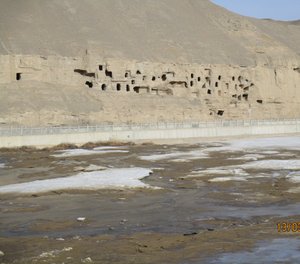Advertisement
Published: March 15th 2018

 Dunhuang Cave complex
Dunhuang Cave complex
Ice, sunshine - pity it is not a better photograph; there are about 1,000 in all, some of them are of almost cathedral size. Reminds one of the chap from St. Kilda who visited St. Mungo's and was astonished - much bigger than any cave at home!A big day today so no breakfast, our guide was here at 08.20 and by 9.00 we were in the theatre of the Dunhuang Caves World Heritage Site pre-visit centre (aka “Mogao Grottoes”). The place was packed, maybe 300 people? Visitors are limited to 3,000 per day, to protect the site. The first film was very Chinese, lots of violence and horses thundering around, but it gave a picture of life as it would have been since the period of the Warring States. We then all moved to a planetarium-style theatre, where you seemed to be moving through a series of the actual caves as the art and history was explained (headphones for English translation); a “virtual reality” experience as if one had super-powers to get close and personal with lofty ceilings etc. An excellent introduction, rather like Newgrange. Then onto a bus to the actual caves, 15 minutes away … this is a huge operation, special buildings, special roads, over 100 buses and the actual site complex was brilliantly managed. No point in my describing the Buddhist art, which is world famous – on a personal level, despite very extensive reading of published accounts, the scale and beauty was much

 Roof timbers
Roof timbers
A little over-engineered?greater than anticipated. Frankly, a very moving experience to see this extraordinary site in reality rather than merely through description and imagination.
The sun, to be lyrical, was shining on the face of the cave-studded cliff face, across the bed of the ice-bound river etc. We saw first the Library cave, and then about 7 others including the (just) 2
nd tallest Buddha in the province, and the reclining Buddha (14.7 metres long), backed by over 60 little statues of the original sponsors. A very interesting roofing detail caught my eye, which I was allowed to photograph; it (as I recall) housed the entrance to a cave which (uniquely) sported medallions or plaques of the individual little portraits that lined the walls. More than one cave pictured Buddhist tales – for example that of the “uncoloured deer”. It seems a person was rescued from the Ganges by a White Deer, and then promised never to reveal the existence of the White Deer; he then told the Queen, who asked to King to capture it as a gift to her, but when the Deer told the King that he had been betrayed by the man he had saved, the

 The Buddha Cave
The Buddha Cave
The cave behind runs the full height of the cliff and is filled by the giant Buddha.King ordered that the Deer be left alone in safety.
Moving on, our guide took us to an excellent local restaurant in town, Chow mien pian, really good at £2.50 a head. We then headed off on a long drive to see the watchtower at Yumenguan Pass, which is graced by a large modern re-interpretation of an armed fort (a bit like the Hadrian’s Wall sort of thing). It was well done and must be hugely popular with school parties etc. Another long drive brought us to the Jade Gate, through which all traffic had to pass on leaving or entering China; another emotive and highly rewarding site – it lay at one time beside a wide water-flow but unfortunately a hydro-scheme further upstream has rather spoiled that aspect of the scene. All the same, we were delighted to see this impressive adobe structure, although we gained very little from the accompanying “museum”. The visitor flow in summer must be astounding, but we had the place virtually to ourselves; incidentally we did finally see our first westerners today. At the caves complex there were two ladies from Europe, resident in Mexico, on a tour leading through “the
‘stans”; Maghnus won 5 Rmb as having spotted them first. The final highlight of our day was a chance to see the final, most westerly end of the Great Wall of the Han dynasty (ca. 200 BC to 200 CE). Totally un-rebuilt, it was simple and enigmatic; just mud, coursed with reeds or tamarisk, according to the terrain.
By the time we got back to Dunhuang the light was fading but we had a quick look at the famous sand dunes before enjoying an excellent dinner in a local Han restaurant, much enlivened by the amorous activities of two besotted members of a party in a private dining room; every now and again they reeled out of the smoking fug for a prolonged and passionate grapple in the main restaurant. All good fun and the entertaining courtship ritual rounded off a great day.
Advertisement
Tot: 0.08s; Tpl: 0.009s; cc: 12; qc: 48; dbt: 0.0441s; 1; m:domysql w:travelblog (10.17.0.13); sld: 1;
; mem: 1.1mb

 Dunhuang Cave complex
Dunhuang Cave complex
 Roof timbers
Roof timbers
 The Buddha Cave
The Buddha Cave




